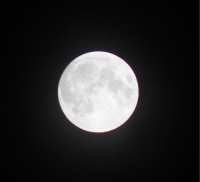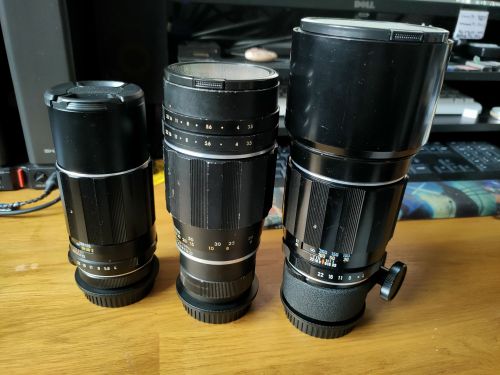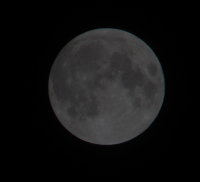This is an old revision of the document!
Night Sky Images - 18/11/2021
I wanted to do a comparison between three of my recently acquired Asahi/Pentax Takumar lenses, this was a full moon, so perfect for some detailed images… also the contrast of the bright moon would definitely show up any image problems inherent with the lenses.
Gear:
- Canon EOS 200D
- Asahi Takumar 200mm/F4, 200mm/F3.5, 300mm/F4
- Tripod
Weather:
- Light to medium cloud (10-30%)
Location:
- Garden
Software
- Rawtherapee - RAW file importing, optical correction & image processing
- ASTAP - Image stacking / general astrophotography toolset
- GIMP - RAW/TIF to JPEG, cropping
From left to right; Super Takumar 200mm/F4, Takumar 200mm/F3.5, and then finally the Super Multi Coated Takumar 300mm/F4:
Images
Shutter speeds were kept at 1/125 and ISO at 100 for all images. I found that all three lenses were able to focus to infinity (actually, all three, to varying degrees, would go beyond infinity) with the fitted M42 to EOS adapters, so no problems there.
All of the images below are 100% size crops of the centre section of the original RAW images without any post processing applied. No optical errors have been corrected, no white balance, gamma or noise reduction operations have been run - these are straight out of the camera, what you see is what you get.
Round 1 - F5.6
All lenses are much too bright fully open at their widest settings (F3.5 and F4, respectively), so the first images were with all three lenses stopped down to F5.6
All three lenses show pretty bad chroma around the high contrast edges of the moon at F5.6. The oldest lens, the non-Super 200mm F3.5, probably has the least of all three lenses and is also definitely the sharpest performing at this aperture.
 Fig. 1: 200mm/F4 @ F5.6
Fig. 1: 200mm/F4 @ F5.6
 Fig. 2: 200mm/F3.5 @ F5.6
Fig. 2: 200mm/F3.5 @ F5.6
 Fig. 3: 300mm/F4 @ F5.6
Fig. 3: 300mm/F4 @ F5.6
Round 2 - F8
On all three lenses, F8 is the next marked stop from F5.6, but is actually two clicks away. I didn't try the mid stop and went straight to F8.
Stopping down to F8 reduces the chroma effect on all three lenses; the 200mm F3.5 again shows the best performance and has a substantial reduction in chroma, to the point where it is almost gone. The Super 200mm F4 is also under a lot more control. The S-M-C 300mm F4 is also reduced, but still comparatively bad compared to the other two.
 Fig. 4: 200mm/F4 @ F8
Fig. 4: 200mm/F4 @ F8
 Fig. 5: 200mm/F3.5 @ F8
Fig. 5: 200mm/F3.5 @ F8
 Fig. 6: 300mm/F4 @ F8
Fig. 6: 300mm/F4 @ F8
Round 3 - F11
On all three lenses, F11 is the next marked stop from F8, but is actually two clicks away. I didn't try the mid stop and went straight to F11.
At F11, both the Super 200mm F4 and the 200mm F3.5 show almost no visible chroma. For all intents and purposes, it is gone. The S-M-C 300mm F4 still shows visible chroma at F11 but chroma aside, it is starting to come into its own in terms of resolution of details on the lunar surface.
Something odd happens with the 200mm F3.5 at this point though, as it starts to get much darker compared to its 200mm and 300mm siblings - it's as if the light entering the lens falls off at a much steeper curve moving to F11 compared to the other two Takumar models - and then remains fairly constant in terms of brightness until F22 (as the subsequent results below indicate). ISO and shutter speed remain constant. I'm not aware that I was taking images with this lens with any substantial cloud cover or similar that would explain the darker images. This definitely needs a follow up session to confirm what I am seeing.
 Fig. 7: 200mm/F4 @ F11
Fig. 7: 200mm/F4 @ F11
 Fig. 8: 200mm/F3.5 @ F11
Fig. 8: 200mm/F3.5 @ F11
 Fig. 9: 300mm/F4 @ F11
Fig. 9: 300mm/F4 @ F11
Round 4 - F16
On the 200mm/F4 and 300mm/F4, they both still have two clicks between F11 and F16. On the 200mm/F3.5, it reduces to just a single stop (no half-stop between apertures at this setting).
The Super 200mm F4 starts to fall off in brightness at F16, but still remains usable without any post processing. No visible chroma at this aperture either. The S-M-C 300mm F4 still remains reasonably bright and chroma is slightly reduced again; red fringes are gone, though the blue/green fringe remains clearly visible without zooming in.
The 200mm F3.5 remains at a brightness level virtually identical to its F11 performance.
 Fig. 10: 200mm/F4 @ F16
Fig. 10: 200mm/F4 @ F16
 Fig. 11: 200mm/F3.5 @ F16
Fig. 11: 200mm/F3.5 @ F16
 Fig. 12: 300mm/F4 @ F16
Fig. 12: 300mm/F4 @ F16




